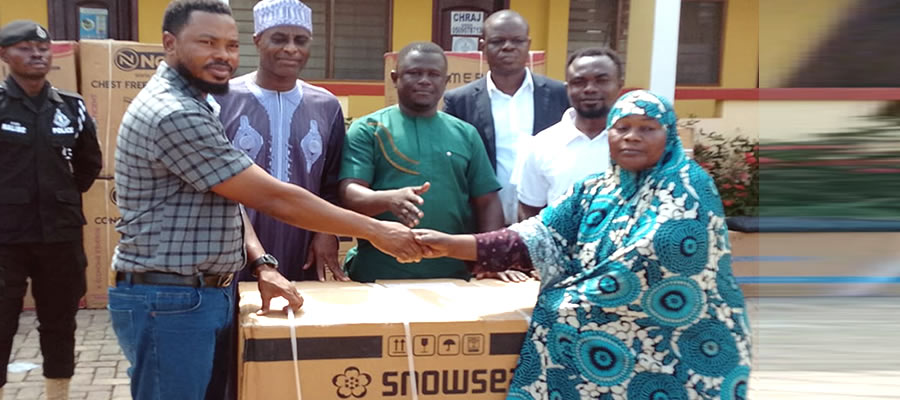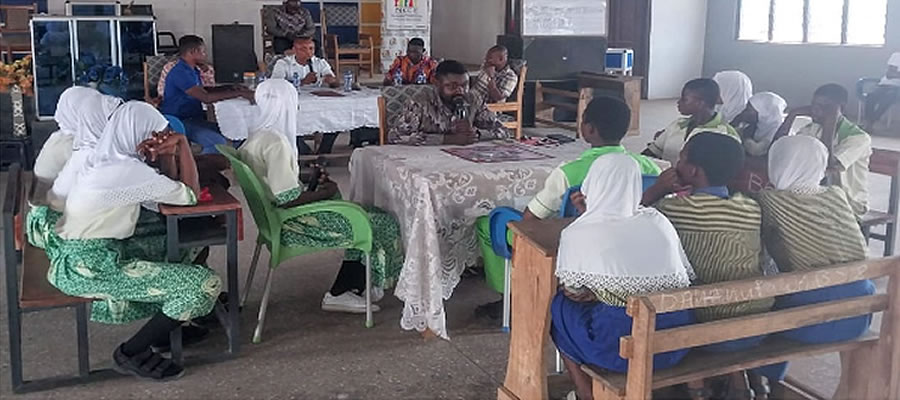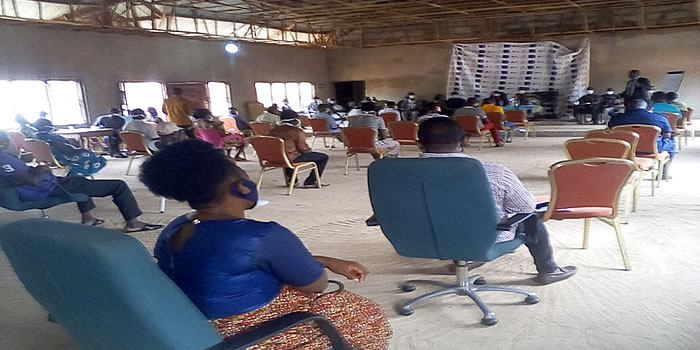

Location and Size
The Pru West District was curved out of the Pru District in December, 2017. The District was established under Legislative Instrument (L.I.2335) of 2017 and inaugurated on 15th March, 2018 Pru West District lies between Longitudes 00 30”W and 10 26”W and Latitudes 7 0 55”N and 8 0 55”N. It shares boundaries with six (6) other districts, namely Pru East District to the north, Sene West Distruct to the east, Nkoranza South Municipal and Atebubu-Amantin Municility to the south and Kintampo-North Municipal and Kintampo South Distruct to the west, all in the Bono East Region.
Prang is the administrative capital of the district with a distance of about 280km (Via Nkoranza/Techiman from Sunyani the Bono Regional Capital. It is also 453km North of Accra, the national capital. The Pru West District covers an area of 2,195kmsq representing about 5.6% of the total land surface of the Brong Ahafo Region.
Climate
The District is located within the transitional zone, thus it experiences the tropical continental or interior Savannah type of climate, which is a modified form of the wet semi-equatorial type of climate. The total annual rainfall ranges between 800mm and 1400mm and occurs in two seasons. The first rainy season begins June whilst the second rainy season begins in September or October. The difference between the minor and major season is hardly noticed due to the transitional nature of the area.
The mean monthly temperature ranges from a height of 300C in March to as low as 240C in August. Mean annual temperature ranges between 26.50C and 27.20C. In extreme cases temperatures rise to about 400C.
The District comes under the influence of the North-east trade winds (Harmattan) between November and March/April. The climate in the District is hardly stable as in some years the rains delay or come in low quantities and in other years the rains come in excess with stormy and torrential down pours, which are sometimes destructive to both crops and the built environment e.g. in 2008 and 2009.
Figure 1.4: Location of the Pru West District in National Context
Figure 1.5: Location of Pru District in the Regional Context
Figure 1.6: Map of Pru West District
Vegetation
The District falls within the interior wooded savanna or tree savannah. However, due to the transitional nature, the area does not exhibit typical savannah conditions. The savannah used to be heavily wooded, though most of the trees are not as tall and gigantic as those in the moist deciduous forest but due to the human activities, the current prevailing natural condition is not the best. There is therefore the need to embark on a Massive tree replanting under the youth in Agro forestry currently introduced by the government.
The existence of “fringe forest” along the banks of rivers, streams and other areas where the impact of human activities are minimal is evidence of the fact that the transitional zone was once forested. Trees are widely scattered in the district. Common trees species found outside the few dotted “fringe forest” include, baobab, dawadawa, acacia, sheanut trees, and mahogany which have adapted to this environment. Grass grows in tussocks and can reach a height of 10 feet or more.
Relief and Drainage
The topography of the district is generally plain with rolling and undulating land surface of an elevation between 60 – 300 meters above sea level. The district is unfortunately not associated with any significant highlands or hills except in the Abease and Benim (Buom) area where a few matured hills and caves can be found.
The Pru River, which is a right tributary to the Volta Lake flows across the Northern part of the district. The Volta Lake and the Pru River almost drains around the District. One does not leave the District without crossing the river and its tributaries. The sluggish flow of the river permits the depositing of alluvial soils on the river beds and along their banks. The fertile nature of alluvial soils is a great potential for increased food production in the district
Soil
Soils in the district belong to a group called “groundwater lateritic soils” which cover nearly three-fifths of the interior wooded savanna zone of Ghana. These soils are formed mainly over Voltaian shales and granites. Most of the soils are fine-textured, ranging from fine sandy loams to clayey loams, and are mostly poorly drained. Crops that can potentially be supported by these soils include rice, vegetables, yams, cassava, maize, groundnuts, soya beans, cowpeas, tobacco and sorghum.
Geology and Minerals
The district is underlain by the voltaian formation which covers about two-fifths of the surface area of Ghana. The rocks belonging to this formation are rich in sandstone, shales, mudstone and limestone which can be harvested for constructional purposes in the district. There are also few deposits of clay which when given the needed attention can boost the pottery industry to generate revenue for the local inhabitants.
The rocks in the area are believed to contain gold deposits; however, no investigation has yet been carried out to corroborate this assertion.
Conditions of the Built Environment Data extracted from the 2010 PHC reports indicates that the District has a total of 9, 579 houses containing about 57,233 households. Out of this number 76.9% of the structures are constructed with mud/mud bricks or earth and 1.3 % palm/earth/thatch. Sand Crete/land Crete forms 4.2%. The main materials used for roofing of dwelling units were corrugated metal sheets (44.2%), thatch/palm leafs (54.3%). Most of the structures in the district are poorly constructed with low quality building materials. The phenomenon is probably due to high poverty levels in the district. There are no drains linking the various structures into a single system. The surroundings are generally unkempt, with exposed foundations and leaking roof of buildings. Deep cracks are also common on structures in the district. The structures in the district in fact are built/put-up in a haphazard manner. Adherence to Building regulations is very poor.
Key Development Issues
1. Poor drainage system
2. Poor quality of building materials
3. Poor hygienic environment
Conditions of the Natural Environment
With the District falling within the interior wooded savannah or tree savannah it faces serious threat of deforestation through pressures from human and animal activities such as housing expansion, farming, overgrazing, bushfires and timber exploitation. These activities have no doubt contributed to the seasonal drying up of some rivers and other water bodies. It is clear that given the current situation, a lot of conscious and sustained efforts will have to be employed if the natural environment is to be restored and resources sustainably exploited. The Youth in afforestation programme under the National Youth employment programme needs to be supported seriously by the District to bridge the gap between the rate exploitation and restocking of the vegetative cover.
Key Development Issues
1. High incidence of bush fires
2. High incidence of illegal chain saw operation
3. High rate of charcoal burning and felling of trees
BIODIVERSITY, CLIMATE CHANGE, GREEN ECONOMY AND ENVIRONMENT IN GENERAL
Climate change is a change in the statistical properties of the climate system, when considered over periods of decades or longer, regardless of cause. Accordingly, fluctuations on periods shorter than a few decades, such as do not represent climate change.
The term is mostly used to refer specifically to climate change caused by human activity, for example, the United Nations Framework Convention on Climate Change defines climate change as "a change of climate which is attributed directly or indirectly to human activity that alters the composition of the global atmosphere, and which is in addition to natural climate variability, observed over comparable time periods.
Climate change in Pru West brought extreme high temperatures leading to evaporation of streams, evapo-transpiration in plants and prolonged droughts, water pollution, etreme rains leading to floods, deforestation and disease infestations. Human activity such as deforestation can be considered a factor which has led to extreme effects of climate change in the district. It is observed that, Pru West district is rural characterized by scattered hamlets. Most of the population is found in these sparse settlements, deforestation is mostly attributed to the people who, day in and day out, cut down smaller trees for charcoal and firewood, for domestic purposes in the rural areas, and in the urban towns
Food production in the district solely depends on the climate, that is to say, crop cultivation depends on the existing rain and weather pattern. Almost all the population relies on the product, both for domestic and commercial purposes. Food crop production and fishing remains the lifewire of the populace in terms of food and employment. Access and availability of food is one of the main concerns of most of the population and accordingly, engaging in agriculture is a good source of income. However, as the people rely so much on the climate to boost the production of its agriculture produce, with the fast-changing of the climate in recent times, agriculture produce might be in danger.
Accordingly, climate change will directly affect future food availability, and compound the difficulties of feeding the rapidly growing population. This has the tendency of putting the growing population in jeopardy making them more prone to risk and vulnerability, or become food insecure during the lean season, or at the onset of a shock, natural, or man-made disaster. In as much as we recognize the implications of the impacts of climate change on the lives of human beings, wetlands and biodiversity, frantic and collaborative efforts must be made by the various stakeholders in the district and beyond so that, lives and properties will be protected with the future safeguarded.
Key Development Issues
1. high temperature
WATER SECURITY
Access to safe water is a pre-requisite for a healthy population. The availability of water systems, their functionality and the quality of water are necessary for the provision of safe water for drinking and domestic purposes.
Pru West enjoys only rural water services from rural water services from the Assembly with technical support from Community Water and Sanitation Agency(CWSA) and non-governmental organizations. A few small communities located along the distribution lines have also been connected to its system.
Data from baseline data collection by SMARTERWASH report indicates that 32.6% of the people had access to safe drinking water in the district. Practically, Small Town Piped Schemes (Prang and Abease) in Per-urban water services to the district have not kept pace with the high demand arising from the rapid population growth of these settlements. This situation has forced the Assembly to intervene by providing financial support to meet demand gaps while individuals have also constructed their limited mechanized piped systems due to the high demand and the quick returns they get on their investments. The situation is far from being resolved as new residential areas continue to spring up amidst the vulnerable nature of the schemes. Even residence in the peri-urban areas still struggle to meet their water needs owing to inefficiency.
In localities where rivers and streams are the major sources of water, there may be serious health implications for the people.
The provision and management of potable water has not been an easy task to the Assembly. The Assembly is currently faced with a number of challenges in its quest to make water accessible to the people. The challenges range from human to natural factors.
There is however potential pollution threats on the water bodies following the onshore oil and gas exploration within the district. Preventive measures ought to be considered by all key stakeholders including Environmental Protection Agency, Ghana National Petroleum Commission, Central Government, NGOs and CSOs in protecting both underground and surface water.
Key Development Issues
1. Occasional drying of handpumps
2. Frequent break down of handpumps
3. Unhygienic wells without protection
4. Low water table
5. Potential pollution from onshore oil exploration
6. Inadequate logistics for field officers
7. Low capacity of Water and Sanitation Management Teams(WSMTs)
NATURAL AND MAN-MADE DISASTERS
The district experiences disasters of varied forms. The predominant natural disaster however is drought and bushfire. There are occasions when rainfall is so erratic that it negatively impacts agricultural activities. When droughts prolong, crops are exposed to pests and diseases of different forms and that can also get catastrophic. Some areas in the district are also susceptible to flooding during periods of excessive rainfall. Areas such as Agyina, Abodwom, Hyreso, among others have experienced floods in the past. It is important for the district disaster management organization to liaise with all stakeholders to identify and map out disaster prone areas in the district so as to enable them develop targeted interventions and as well respond timely and appropriately before and or after disasters occur.
Key development Issues
· Frequent bush fires
· Flooding
NATURAL RESOURCE UTILIZATION
Man has always sought to improve his physical surroundings to make it more habitable. Over the years considerable amount of energy is being put into activities aimed at improving the welfare of mankind. Some of these measures include the construction of physical infrastructure such as schools, hospitals, roads, bridges, water facilities, toilets, houses etc. Although these interventions help mitigate major human sufferings, they sometimes impact negatively on the environment which supports our existence on this earth.
The 2010 Population and Housing Census put the growth rate of Pru district at 3.0% rates slightly higher than the national figure of 2.7%. This is an indication that the growth of the local context population is higher than the national growth. The people in the district derive mainly their livelihoods from the environment thus the land for farming, animal husbandry and settlements and the rivers (Volta Lake and Pru) for fishing and transportation. Juxtaposing the rapid population growth and the daily requirement of the population imply much pressure on the natural resources to meet the growing demand.
Population and development are inextricably related as changes in one extreme invariably affect the other. Everything that humans do has some impact on the environment. Pollution is a result of human activities on the environment. The main sources of pollution are farming, water pollution and air pollution. Farming is having an increased impact on the environment. This is because there is increased pressure on farmers to produce a single crop and to concentrate on one form of animal husbandry, such as, dairy cattle or pig breeding. Monocultures are produced from this, which are large areas of the same crop grown on the same land year after year.
To explore the impacts of increasing human numbers on nature, many changes have been observed in the district regarding the relationships between human population density (HPD) and biodiversity. The implicit assumption in many of these observations is that as population density increases so does the threat to biodiversity. The implications of this assumption are compounded in our understanding that, species richness for many taxonomic groups is often highest in areas with high human population density. If increasing human population density is a threat to conservation, this threat may be magnified owing to the spatial congruence between people and species richness. In light of this, recognition must be given to the relationships between human population density and measures of biodiversity status focusing in particular on evidence for the spatial congruence between people and species richness and the threat that increasing human population density may pose to biodiversity conservation.
Our understanding of the relationships between human population density and biodiversity is skewed by geographic and taxonomic biases. The most convincing indication of the negative impact of increasing human population density was a significant negative population correlation between density and the size of protected areas. The magnitude and implications of spatial congruence between people and biodiversity should be explored using the principles of complementarily and irreplaceability. Human development as a threat to conservation should be assessed within a complex, interdisciplinary framework, although population size is still considered a key factor. Future population growth and expansion of human settlements in the district will present increasing challenges for conserving species-rich regions and maximizing the benefits humans gain from nature.
Human activities have a major impact on the biodiversity, while biodiversity change is considered as an important global change in its own right. Experiences in the district have shown that, the effect of human activities on soil environment and plant diversity showed that the main soil environmental factors and plant species diversity had some obvious changes, of which, the changes of man-made pine woods and heavy grazing disturbance were the largest. It is suggested that natural laws and consistency of ecosystem processes in the low and long temporal scale should be considered adequately in the management of the environment.
Industrialization and Modernization has brought about a drastic change in the quality of the environment. Industrial pollution has caused air, water and land pollution. The emissions from the vehicles and the industries have caused the deterioration in the quality of air. The waste water generated from domestic and effluents released from industries are being sent directly to the rivers thereby deteriorating the water quality. Lack of waste management practices has also had a negative effect on the quality of the environment. Human activities like burning of electronic wastes (e-wastes) and plastics have caused release of carcinogenic substances. Dumping of wastes in landfills has also caused slow seepage of wastes into the ground thereby polluting the land and also polluting water in the nearby vicinity.
This way, the effect of human activities has been unexplainably and extraordinarily huge. Human activities, industrialization, modernization and rapid advancement in technology have had pernicious effects on the quality of the environment. There has been degradation of the quality of air, water and land. The need for economic growth by the nation and for that matter the district has put everybody in a race which in turn has had a negative effect on the quality of the environment. Individuals and organization are exploiting the natural resources present for a better living, but the repercussions are felt on the quality of the environment in threefold.
Date Created : 7/6/2023 12:00:00 AM










 facebook
facebook
 twitter
twitter
 Youtube
Youtube
 +233 593 831 280
+233 593 831 280 0800 430 430
0800 430 430 GPS: GE-231-4383
GPS: GE-231-4383 info@ghanadistricts.com
info@ghanadistricts.com Box GP1044, Accra, Ghana
Box GP1044, Accra, Ghana